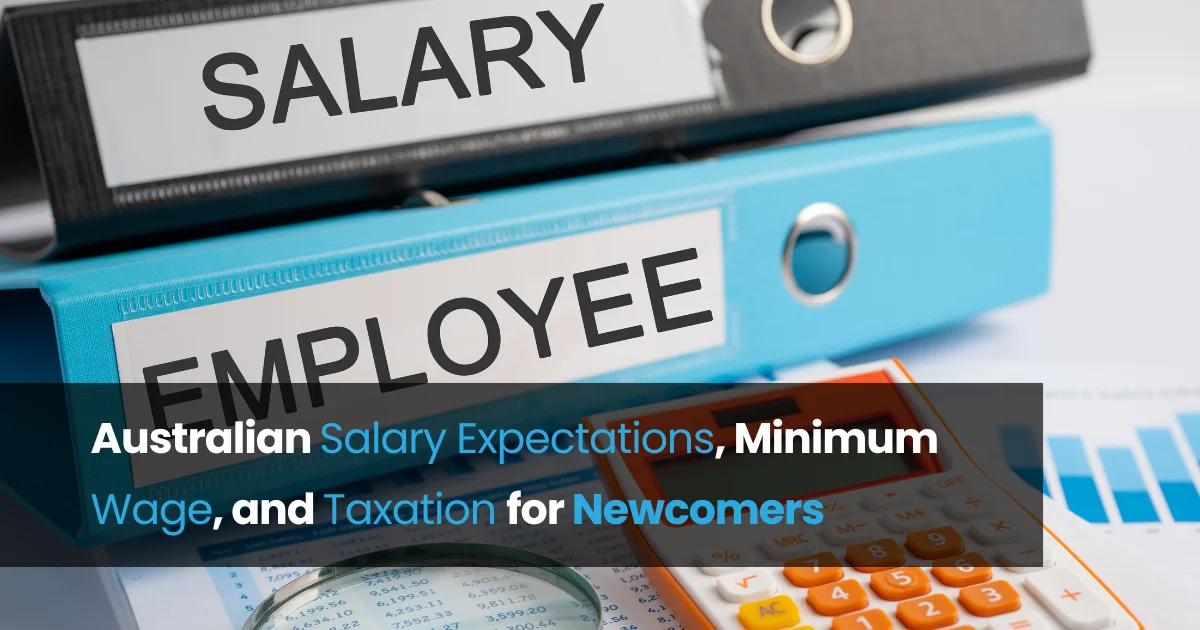For newcomers to Australia, understanding salary expectations, the minimum wage, and the tax system is crucial for managing finances and making informed career decisions. We provide an overview of average salaries, minimum wage rates, and income tax brackets to help newcomers plan their financial journey in Australia.
Average Salary Expectations in Australia
Australia’s average salaries vary significantly based on industry, experience, and location. Here’s a general breakdown of average annual salaries for key professions and industries:
| Industry/Profession | Average Salary (AUD) |
|---|---|
| Information Technology | $90,000 – $120,000 |
| Healthcare & Nursing | $75,000 – $110,000 |
| Engineering | $80,000 – $110,000 |
| Education | $70,000 – $100,000 |
| Finance & Accounting | $70,000 – $100,000 |
| Construction & Trades | $65,000 – $90,000 |
| Hospitality & Tourism | $50,000 – $75,000 |
| Retail | $50,000 – $70,000 |
- Source: Australian Bureau of Statistics
These salary ranges represent full-time annual wages and can vary by factors such as skill level, qualifications, and regional demand.
Minimum Wage in Australia
Australia’s minimum wage is among the highest globally. As of 2024, the national minimum wage is $23.23 per hour, or $882.80 per 38-hour week (before tax).
- Casual Loading: For casual employees, an additional 25% loading is typically added, bringing the casual minimum wage to approximately $29.04 per hour.
- Annual Adjustments: Minimum wage rates are reviewed annually by the Fair Work Commission, with adjustments announced in July each year.
Comparison of Australia’s Minimum Wage with Other Countries
| Country | Minimum Wage (AUD Equivalent) |
|---|---|
| Australia | $23.23 per hour |
| United States | $10.25 per hour |
| United Kingdom | $14.50 per hour |
| Canada | $14.50 per hour |
| New Zealand | $22.70 per hour |
People also read: Why Move to Australia? Benefits of Migrating to the Land Down Under
Taxation for Newcomers
Understanding Australia’s tax system is essential for newcomers to manage their income effectively. The country uses a progressive income tax system where rates increase with income levels. Here’s an overview of the primary tax elements:
Income Tax Brackets (2024)
| Income Range (AUD) | Tax Rate |
|---|---|
| $0 – $18,200 | 0% |
| $18,201 – $45,000 | 19% |
| $45,001 – $120,000 | 32.5% |
| $120,001 – $180,000 | 37% |
| $180,001 and above | 45% |
- Example Calculation: If you earn $60,000 per year, your tax would be calculated based on each tier up to your income level. Calculations are made by applying each tax rate progressively, not on the total income.
Additional Taxes
- Medicare Levy: Most taxpayers are required to pay a Medicare levy of 2% of their taxable income to fund Australia’s healthcare system. Low-income earners may be exempt or pay a reduced rate.
- Medicare Levy Surcharge: High-income earners without private health insurance may be subject to an additional surcharge (1-1.5% of taxable income).
- Superannuation (Super): Employers contribute a mandatory 11% of an employee’s salary into a retirement fund called “superannuation,” which can be withdrawn after retirement or upon permanent departure from Australia.
Breakdown of Taxation Components
Below is a table illustrating the percentage of income typically allocated to each tax component for a sample annual income of $60,000:
| Component | Percentage of Income (%) |
|---|---|
| Income Tax | 14% |
| Medicare Levy | 2% |
| Superannuation (employer contribution) | 11% |
People also read: How to Apply for Australia Skilled Regional Visas
Financial Planning Tips for Newcomers
Moving to Australia is a significant financial decision, so here are some essential tips to help newcomers plan their finances effectively:
- Budgeting: Include fixed costs such as rent, utilities, and transportation, along with estimated tax and superannuation deductions.
- Superannuation Management: Choose a suitable super fund to optimize retirement savings, especially if you plan to stay long-term.
- Tax File Number (TFN): Apply for a Tax File Number (TFN) upon arrival to avoid higher tax rates and simplify tax returns.
- Explore Government Benefits: Some migrants may be eligible for family tax benefits, healthcare benefits, or low-income tax offsets.
Understanding Australia’s salary expectations, minimum wage, and taxation can greatly aid newcomers in planning for financial success. With a clear picture of income expectations and tax obligations, you’ll be well-equipped to make the most of Australia’s strong economic landscape and build a stable foundation for your future.
FAQs
- What happens if I don’t apply for a TFN?
- Without a TFN, your income is taxed at the highest rate. It’s best to apply for a TFN upon arrival.
- Are there additional tax deductions available?
- Yes, depending on your income and personal circumstances, you can claim deductions for work-related expenses, donations, and even education costs.
- How is casual work taxed?
- Casual work is taxed similarly to full-time work, but with no job security benefits, so ensure you set aside funds to cover taxes if you’re in a casual role.
- Can I access my superannuation if I leave Australia?
- Yes, temporary visa holders can claim their super when leaving Australia permanently by applying for a Departing Australia Superannuation Payment (DASP).






